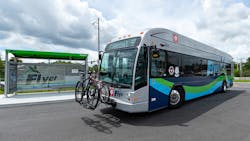With President Joe Biden’s $1.2 trillion Bipartisan Infrastructure Deal comes billions to upgrade passenger and freight rail and public transit.
Many municipalities are already chomping at the bit, earmarking that influx of taxpayer money for a variety of public transit initiatives including construction of heavy, light and commuter rail lines and improvements in local bus service. A much better solution may be one that is often overlooked despite the fact that it is more flexible, economically feasible and environmentally friendly than fixed rail projects: Bus Rapid Transit (BRT).
Despite its successful implementation in other parts of the world (in Latin America, for example, BRT transports some 20 million people daily in 54 cities), only 13 U.S. cities have deployed BRT corridors to date. This may be largely attributable to skepticism on the part of some transportation experts that BRT amounts to little more than a limited upgrade of existing bus service. Cynics contend BRT will do little to tame urban sprawl or lure suburban drivers out of their own cars.
Buoyed by $375 million in coronavirus relief funds already provided by the Federal Transit Administration, BRT is gradually gaining steam, particularly in smaller, less dense municipalities where subways and light rail are harder to justify.
Baltimore offers a good case in point. Local officials there are championing a light-rail system, which carries with it a price tag of $250-300 million. With a population density in the range of 10 persons per acre, Baltimore lacks the kind of density (20-30 persons per acre) required to make that kind of expenditure worthwhile. With its ability to move up to 15,000 persons per hour, BRT could offer a viable alternative.
In strict dollar terms, the cost per mile of a typical BRT system is about 20 percent of the cost of a fixed rail system. With light rail costs averaging $150-250 million per mile and subway lines running $200-345 million per mile, BRT has an advantage in a dollar-to-dollar comparison.
But in evaluating costs, municipalities also need to factor in the economic development benefits when comparing BRT to a fixed rail system. In Cleveland, Ohio, for example, the original BRT program cost $50 million. That modest investment has delivered a $114.54 gained for every dollar spent on BRT development and implementation. The value of office space within a quarter mile of the BRT lineis 18 percent higher than comparable space beyond walking distance, while two-thirds of new jobs were generated within a block of a BRT station.
This case isn’t unique to Cleveland. A recent University of Arizona study examining job and residential growth around BRT stations in 11 cities found that areas close to the stations accounted for a significant percentage of regional growth. Jacksonville, Fla., which has 45 miles of BRT lines and is currently working on another 12-mile route, has seen $1.6 billion in residential and commercial permit requests within a half-mile of its BRT lines.
Apart from lower costs and the accompanying economic development benefits, BRT provides a number of other advantages, ranging from shorter, less complex planning and construction phases to faster, more reliable service arising from its dedicated lane infrastructure.
At a time when environmental concerns are rapidly becoming of paramount concern, BRT also offers a sustainable transit solution. Through its use of fuel-efficient technologies, BRT buses reduce the amount of carbon emissions and other harmful pollutants from becoming airborne. Mexico City’s Metrobus 3, for example, has cut annual carbon emission by 35,000 tons. Bogota’s TransMilenio has helped to reduce CO2 emissions by nearly a million tons each year.
BRT also lowers the overall amount of vehicle miles traveled by replacing single-occupancy vehicles with high-capacity buses capable of carrying 160 passengers, including those standing. The trick, of course, comes in building and marketing a BRT system that will convince potential riders to give it a try and then demonstrating that it is, in fact, faster and easier to use than fixed rail or personal vehicles.
To that end, it is essential for BRT systems to offer potential users transit stops in one-mile intervals, dedicated lanes, traffic signal priority, level boarding with a minimum of two entry doors per vehicle and off-vehicle payment systems. To do less will inevitably frustrate riders and undercut the level of use needed to make the BRT system successful.
The good news is that there increasingly are a number of best practices that municipalities can employ. In Seattle, for example, riders can easily transfer from light rail to BRT. Queue jump lanes enable BRT vehicles to start before other traffic at stop lights, while bus-only lanes go to the most congested locations.
Toronto offers amenities only found in the newest, state-of-the-art system, including BRT vehicles which arrive every five minutes during morning and evening rush hours. Toronto also invested heavily in marketing its BRT system on the lifestyle it provides to offset the stigma sometimes associated with transit buses.
Bottom line, BRT can be a highly effective and economical means for providing mass transit in the right geography. The key is for municipalities to do their homework up front, make certain it will be a fit for the market’s population density, investigate what has worked (and what hasn’t) in comparable markets, and most importantly, make sure that the R in BRT continues to stand for rapid. So long as BRT lives up to its promise to move riders rapidly from Point A to Point B, it will succeed and yield benefits that outweigh any advantages offered by fixed rail alternatives.
Wes Guckert, PTP, is president and CEO of The Traffic Group, a leading Service-Disabled Veteran-Owned Small Business traffic engineering and transportation planning firm serving clients nationally and internationally. He is also a fellow of ITE and serves on the National Small Business Leadership Council.
